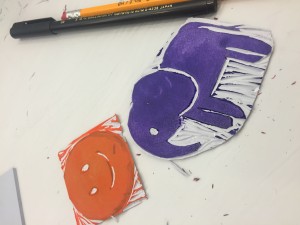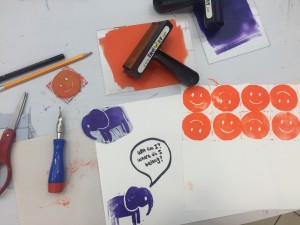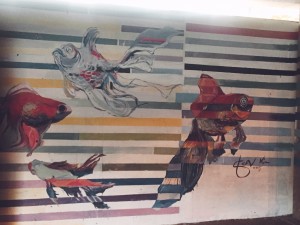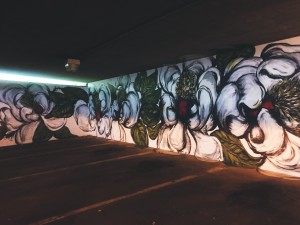Last Thursday, at the Johnson, we carved linoleum. For those of you who don’t know what linoleum carving is, it’s a print-making technique in which you utilize a sharp, curved tool to work away at a pliable but tough rubbery surface. Because it is a print-making technique, it’s important to keep in mind while carving that what you carve away will be both reversed and negated eventually when you print it. I’ve taken a print-making class before, and for a project, we had to carve away at the same block gradually, printing different layers of colors in intervals until we achieved the picture we wanted. In this class, we did a simple, single-layer color block.



Author Archives: Sophia He
The Great Intangible
The conundrum when it comes to love is that we all have different definitions for the word. Some use the term loosely, some use the term exclusively, but we all know what it is. Or at least, we all know how it feels. Prolific scholar bell hooks, who chooses to spell her name uncapitalized in order to draw more focus to her message, challenges us to not treat love as a feeling, but as an action. She argues that because we treat love as instinctual, the inducer of our actions, we allow ourselves to believe we simply “fall” in love, and we cannot control it when we do. This belief, that we lack control, makes excuses for “crimes of passion” such as abuse. She states, “We cannot claim to love if we are hurtful and abusive,” and to use love as an excuse for hurting someone is to devalue and degrade its meaning.Perhaps we are afraid to choose love as an action, as a choice. Perhaps our belief that certain loves are innate has made us passive.
Ithaca isn’t just Gorges
So, I’m not just speaking for myself when I say that I have certain gripes against certain aspects of Ithaca. Namely its freeeeezing can’t-feel-your-fingers winters and the hills that make you never want to walk again.
However, I will say this. Ithaca is Gorges. That’s right, everyone. I’m sure you’ve all heard it before, seen it before, in a cheesy tag line trying to get you to come to Cornell back in the day when you were debating whether your SAT score was high enough, on the shirt of the creepy guy in fake Ray-Bans who drunkenly tried to make out with you on slope day (true story), etc. BUT did you know Ithaca isn’t just Gorges because of the gorges????? (Okay, at this point you’re most likely sick of the pun, and I will return to the conventional spelling of “gorgeous.” Thank you for bearing with me.)
One thing that makes Ithaca not only beautiful, but distinct, is the public art. I’m sure if any of you have walked about the city, you’ve noticed the impressionable wall-to-wall murals encompassing the sides of parking garages and public buildings.
On our public art tour last Saturday, led by friendly local, Caleb, we got to examine these paintings up close and learn their histories. Caleb is part of the public art commission, and he helps to organize suggestions and work with artists on their projects.
We started our tour in a parking lot in Collegetown and progressed downhill until we reached the another parking garage on North Tioga Street. We walked along Seneca Street and walked around to Green Street, where we ended our tour.
Caleb brought up a lot of topics relating to public art I had never really thought of in depth before. What may we consider art? Are these paintings that undergo a tedious three-month process to be approved any more considered “art” than the graffiti sprayed on the walls by anonymous individuals in the cover of night? He also brought us to a couple of controversial pieces, one on Seneca Street, if I remember correctly, which features a wall of Indian chiefs coming together in peace. While some find it positive because it opens conversation on and brings awareness to Indian tribes while giving a nod to the physical genocides of the past and the cultural genocide of the now, others feel that it misrepresents the culture, because tribes are matrilineal, represented by women, but this painting shows them to be represented by men. To make up for it, the artist painted strawberries on the mural to represent women and their fertility and cultivating nature as well as their importance to the lineage, but is that enough?
For more information, you can like the Facebook page Ithacans for Public Art.
Car(v)e for Yourself
So I think we can all agree that we’re pretty stressed at the moment.
But while we are in the midst of studying and doing problem sets and writing papers, let’s not forget we are actual human beings who need to eat and breathe and sleep, as it is so easy to do.
So take a break! Go watch a movie or take a walk or get that extra hour of sleep! Do something fun for Halloween! Care for yourself.
Go back to her
Last week, when I saw the Amy Winehouse documentary, when I saw her life torn to shreds through the eye of a lens, I felt guilt.
That may be a strange feeling, me having played no part in her demise, having been only familiar with only a few of her songs pre-movie experience. But let me explain.
The movie is set up in a way in that you first see home videos of young Amy, singing Happy Birthday with her belly voice, carefree. You watch as she gradually gains fame, see her performing in jazz clubs, see her on talk shows, see her build momentum as an artist. See all her optimism, but also all her self doubt. Then, you watch her fall in love, have her heart broken, have all her pains displayed for the world to see. You watch her battle her drug habit, you watch the people she loves manipulating her, leaving her; you watch her win, lose, win, lose again. Until all her battles have been fought, and you watch her body as it is carried out of her mansion in a bag, lifeless.
The thing about this documentary is that it is invasive. Sure, okay, she’s dead. Sure, okay, someone, somewhere, signed some contract and all the clips featured are fine and legal. But you can even see, as the movie progresses, that the video clips of her life become a nuisance to her. She is no longer the happy teen singing Happy Birthday to the camera. The videos are no longer home videos. They are videos taken by the paparazzi, by people who are strangers to her. Even when using videos shot by her father and his crew, she expresses distress. She does not want them there. In all our attempts to get closer, as we try to catch a more intimate glimpse of her life, we somehow grow farther from her with each step.
Until finally, we realize. We are still invading her life. Here we are watching a documentary about her, thinking we are respecting her, understanding her, but in reality, the movie is an antithesis of itself.
Amy Winehouse went off the deep end because of how centered she was in the eye of the public. She was attacked, exploited, in a feeding frenzy in which we were the predators and she was the prey. And even after her death, we are still watching her, still judging her, still preying.
We have room here tho
On our tour of Cornell we learned about Yale.
For housing, each Yale student is assigned a residential “college,” which they remain in for the rest of their years there. While this doesn’t exactly allow room for interaction with the outside community, it builds a community and solidarity between students. Yale alumni aren’t identified by what major they were; they are identified by what designated residential college they lived in.
Also, apparently, since Yale originally housed only elitist White Anglo-Saxon Protestant males in the 1700’s, dorms include one large bedroom–originally meant for the student– and one small bedroom– originally meant for the student’s servant– so Yalies would have to deck it out between roommates to see who gets the bigger bedroom.
So that’s fun!
Professor Cheyfitz on the Black-White Binary
Last Wednesday, I attended Professor Eric Cheyfitz’s talk about American Indians and their rights (or lack of rights) in the United States. He spoke about the three types of hegemonial genocides the Indians experienced: genocide in the form of violence, genocide in the form of disease, and genocide in the form of cultural repression. He also spoke about the principles of sovereignty and the oxymoron that is the term “domestically-dependent nation,” used to describe the Indian nations on (supposedly) American ground.
However, what most caught my interest during the talk was when Professor Cheyfitz mentioned what he called the “Black-White binary” that exists in our culture today. You know what I’m talking about. The ever-present Black-vs-White war going on that we all automatically think of when we think “racism.” It’s been engrained in us ever since kindergarten history story time, when we learned, and I quote from my five-year-old little sister, “Martin Luther King, Jr. made the world fair.”
While I do agree that the institutionalized racism that Black people experience must be brought to attention in order to be minimalized, I also agree with Professor Cheyfitz in that focusing on this as the “main” form of racism sweeps other minorities’ problems under the carpet in a way. The cultural marginalization experienced by the American Indians, the comments about immigration and how “you speak so well” experienced by Latino Americans, the “model minority” pressure experienced by Asian Americans are easily-ignored microagressions when compared to the events that occurred in Ferguson, Baltimore, and Charleston this past year. But why must we compare? Why must we categorize between “racism” and “not-so-bad racism”? Are we not all fighting for the same equality?
Professir Cheyfitz thinks we can combat this by educating. Focus on more than the African American Civil Rights Movement when teaching about racial history. Expand the lesson plan to incorporate the genocide experienced by the American Indians, the cultural oppression they faced. And speak not just of the bad, but the good as well. Talk about their culture in a new light; mention the medicinal knowledge they house and their deeply rooted connection to the land. And do this not just for American Indian history, but for the histories of other minorities as well. Teach our children that the world isn’t fair, not yet, but it can be.









